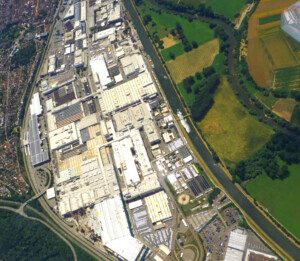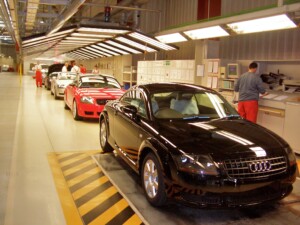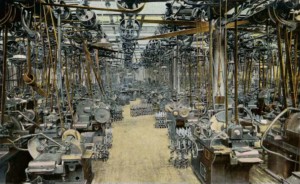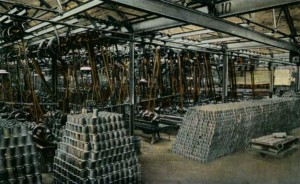 Assembly lines are THE way to do mass production. Yet, with constant regularity people try out to undo the assembly line, only to fail in their endeavor. In my previous post I looked at examples by Volkswagen in Salzgitter, Volvo in Kalmar, and Opel in Bochum, who all tried, just to switch back to an assembly line afterwards. This second post in this series has more historical examples of when people tried and failed to undo assembly lines in mass production.
Assembly lines are THE way to do mass production. Yet, with constant regularity people try out to undo the assembly line, only to fail in their endeavor. In my previous post I looked at examples by Volkswagen in Salzgitter, Volvo in Kalmar, and Opel in Bochum, who all tried, just to switch back to an assembly line afterwards. This second post in this series has more historical examples of when people tried and failed to undo assembly lines in mass production.
Volvo Uddevalla 1990
![]() In 1990, Volvo conducted another experiment in their Uddevalla plant, very similar to the Kalmar plant from 1984. They also eliminated assembly lines and instead used parallel stations for car assembly. This was a pet project of Volvo CEO Pehr G. Gyllenhammar.
In 1990, Volvo conducted another experiment in their Uddevalla plant, very similar to the Kalmar plant from 1984. They also eliminated assembly lines and instead used parallel stations for car assembly. This was a pet project of Volvo CEO Pehr G. Gyllenhammar.
Initially, the plant had seven hundred people on an assembly line, but this was changed to forty-eight parallel stations, where each product shop had eight teams with about nine workers. Each team assembled complete cars independently of other teams, without moving the car more than once. In average, each worker built one-quarter of a car. There were no supervisors, only an ombudsman.
The results of the experiment were similar to the previous experiment in Kalmar. While performance was not really bad compared with other Swedish Volvo plants, it was far behind Toyota in Japan or the US Toyota GM joint venture NUMMI. There were some productivity problems and it was difficult to improve due to a lack of standards and also standards for improvement. The experiment lasted four years, and the plant was closed in 1994. The general reason for the closure was that Volvo had overcapacity. However, car makers usually don’t close their good plants but rather the under-performing plants. Hence, this experiment also lasted only four years. It seems they did not learn the lesson from Kalmar.
Mercedes-Benz Rastatt 1992

The Mercedes-Benz plant in Rastatt, Germany, is the third automotive final assembly plant of Mercedes-Benz in Germany. Production started in 1992, and the plant was inspired by the Volvo Uddevalla and Kalmar plants. It was designed as a modern, humane factory (“Humane Fabrik”), with the cooperation of the Daimler-Benz Board of Management and the workers’ representative. The goal was to avoid assembly lines and instead use box production (“Boxenfertigung”) and group work. While there were still assembly lines, there was a large push to install such group-based manufacturing wherever possible.
Operations that were most affected by model-mix variation, such as interior trim and wiring harness installation, became stationary workplaces with individual work cycles ranging between 70 and 120 minutes. Other operations were performed on assembly lines with a takt between five and twenty-five minutes, depending on the type of assembly. This was not a complete repeat of Volvoism, but rather a testing of the waters.
However, the experiment lasted only four years. In 1996, when the plant started producing the A-class, the approach was completely reversed, and the plant now mostly uses assembly lines.
Audi Neckarsulm and Györ 2017

In 2017, Audi announced its intention to abolish the assembly line in its Neckarsulm plant in Germany and subsequently also the Györ plant in Hungary. Instead, the company planned to move toward flexible assembly islands, a concept known as modular assembly (“Modulare Montage”). This approach was implemented for the R8 sports car in Neckarsulm and was planned for the Györ plant in Hungary.
The new system involves the use of two hundred assembly stations, supplied by Automated Guided Vehicles (AGVs), instead of a single assembly line. Audi claims that this approach is highly flexible and more robust. A central computer controls the AGVs to ensure a flawless production sequence. There were many news articles about thie “end of the assembly line,” including plenty of popular buzzwords like big data, digital processes, Supply Chain 4.0, and Smart factory.

However, there has been little news about the success of this approach since 2022. I believe that this initiative also died out like all the others before it. Also, in my opinion, while car makers often exaggerate their abilities and achievements, Audi seems to do this more enthusiastically than the others.
Problems with Box Production

Flow shops, also known as assembly lines, are superior to job shops for mass production. I have written a lot about this in previous posts like Why Are Job Shops Always Such a Chaotic Mess? and Performance Comparison of Job Shop and Flow Shop.
In flow shops, all material moves in the same direction, making it easier to manage. Parts always need to go to the same location on the shop floor, making it easier to set up, for example, using milk runs. In contrast, job shops have irregular material flow, causing imbalances and fluctuations in inventory, which in turn increases the inventory.
A job shop is harder to organize. Workers may have to switch stations often because of the changes. This is not required on an assembly line. This also causes process downtime while it waits for workers.

Generally, job shops require more time to look for material or work and to arrange the system. It is also harder to plan, as lead times are more variable. Small delays at one station can have a ripple effect and ruin your whole production plan, making these variations even worse. The system reacts to its problems only after they occur, not before.
In general, job shops require more time invested in searching for material or work, and organizing the system. It is also more difficult to plan, as lead times tend to fluctuate. Problems are less urgent and less likely to be fixed since they affect only one station instead of the entire line.
It is also much more difficult to standardize job shops, resulting in fewer or no standards. And, you cannot improve a production system if you don’t have standards. Hence, it also more difficult to improve the system. On top of that, problems are less urgent and hence less likely to be fixed, since they affect only one station instead of the entire line.
Overall, the assembly line is and remains king in manufacturing. Even with a lot of effort, going back to box production or job shops will worsen the performance of the system. In the past, many people have tried and failed with undoing an assembly line and installing group work. These two posts are merely a selection of examples with a focus on car makers. I am sure, in the future, even more people will try and fail. Now, go out, learn lessons from history, and organize your industry!

Mercedes also had something similar in Sindelfingen in the late 1990s. A colleague and I were helping them with genba kanri elsewhere (its a massive plant!) and we took a look inside the modular assembly building one day. It all seemed very relaxed! I can’t recall which models they were working on, but they were high-end vehicles presumably with a comfortable margin which could absorb the labour cost.